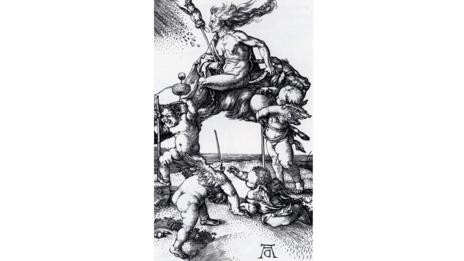For art historians, though, the interesting question is what provided Renaissance artists with the model for this appalling vision. One theory is that Dürer and his contemporaries were inspired by the personification of Envy as conceived by the Italian artist Andrea Mantegna (c 1431-1506) in his engraving Battle of the Sea Gods.
“Mantegna’s figure of Envy formed a kind of call for the Renaissance of the witch as a hideous old hag,” explains the artist and writer Deanna Petherbridge, who has co-curated the exhibition at the British Museum. “Envy was emaciated, her breasts were no longer good, which is why she was jealous of women, and she attacked babies and ate them. She often had snakes for hair.”

Another of Durer's etchings shows a witch riding backwards on a goat, with four putti (The Trustees of the British Museum)
A good example of this Envy-type of witch can be seen in an extraordinarily intense Italian print known as Lo Stregozzo (The Witch’s Procession) (c 1520). Here, a malevolent witch with open mouth, hair in turmoil and desiccated dugs clutches a steaming pot (or cauldron), and rides a fantastical, monstrous skeleton. Her right hand reaches for the head of a baby from the heap of infants at her feet.


沒有留言:
張貼留言